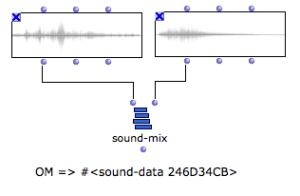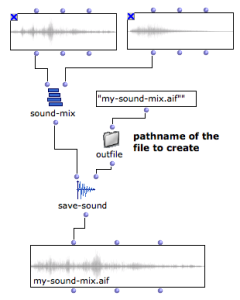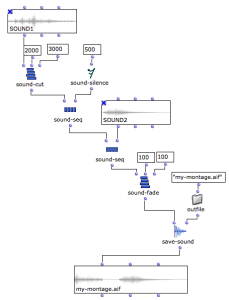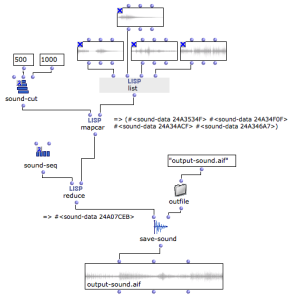Sound Processing Functions
There exist a number of functions allowing to manipulate sound and audio data. A number of them are based on the underlying LibAudioStream library functionalities.
General Principles
The LibAudioStream library used by OM manipulates sound resources under the form of " streams ". Streams can be seen as abstact pointers representing a sound and possible transformations. In OM the LibAudioStream streams are embedded in a structure called SOUND-DATA. |  The SOUND-MIX function creates a SOUND-DATA pointer corresponding to the mix of two sounds. |
Processing Functions
Below are listed the available sound processing functions. They all produce SOUND-DATA pointers.
SOUND-MIX : mixes two input sounds
SOUND-SEQ : concatenates two input sounds
SOUND-VOL : modifies the volume of an input sound
SOUND-CUT: extracts a specified interval out of an inpt sound
SOUND-FADE : adds a fade-in / fade-out effect to an input sound
SOUND-LOOP : repeats an input sound a number of times
SOUND-SILENCE : generates and empty (silent) sound of a given duration.
See the individual box documentation (press d) for more detailed descriptions.
Cascading Processes
The sound processing tools can also apply directly on SOUND-DATA pointers. It is therefore possible to apply sequences and combinations of effects and processes without using intermediary files.
SAVE-SOUND can be used eventually to store the final sound result in a sound file.
This example implements the following process :
|
Automating Processing
The different programming facilities provided in OM (iterations, etc.) might be useful to automate sound processing on sound files and SOUND-DATA pointers.
In this example, we use higher-order functions in order to process lists of sound files and pointers.
(More advanced processed could be imagined, and implemented with abstractions or using an omloop). |



